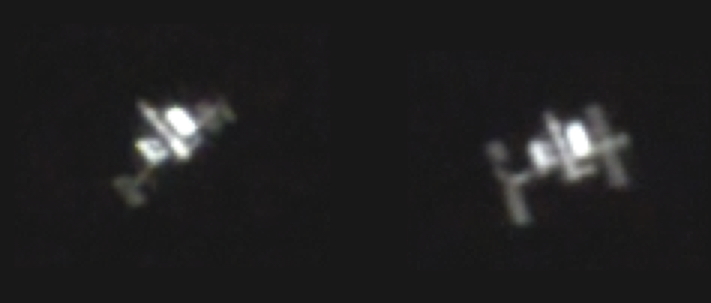
ISS Imaged, Wi-Fi Adapter Tests
Posted: 7 April 2013
An excellent pass of the International Space Station (ISS) would occur Saturday night, 6 April 2013, giving me my first chance to try out the Antares 7x50 Illuminated Crosshairs Finderscope which I recently purchased mainly for use to track satellites. However, cloud coverage went from clear in the morning to numerous thin clouds at sunset. But in case there was a break in the clouds for the pass, I opened the observatory anyway at 1802 MST, 86°F. While waiting for darkness and the ISS pass, I set up the Wi-Fi adapter I'm testing and connected it to the 8" LX200-ACF.
At 1836 MST, I powered on the telescope and Wi-Fi adapter. At 1838 MST, still several minutes before sunset, I viewed Jupiter, 77X. Three moons were visible against the bright sky. I then did some initial tests of the Wi-Fi adapter using SkySafari Pro on the iPhone 4.
Next, I updated the ISS TLE using the AutoStar II handcontroller. I returned to observing Jupiter, 77X, at 1857 MST. The sun had set and four moons were now visible. At 1922 MST, the view of Jupiter was hampered by thin clouds.
At 1924 MST, slewed to Sirius, which would be the focus test star using a Bahtinov Mask. Mounted the D7000 DSLR at prime focus. At 1930 MST, did a focus test exposure, locked the telescope focus, and checked the finderscope alignment. Beginning at 1934 MST, watched a nice pass of the Hubble Space Telescope (HST). It flared brightly as it passed through Orion. At 1950 MST, all was ready for imaging the ISS. There were only a few clouds along the path that might cause problems.
The ISS pass was a very bright and high one, passing near the zenith. AutoStar tracking was very good. And the illuminated crosshairs in the Antares finderscope really helped. I was easily able to keep the ISS inside the box in the dual crosshairs for most of the pass. The right angle view through the finderscope also helped my tracking, especially when the finderscope was pointed vertically as the ISS neared the zenith. With a straight through finderscope I would not have been able to look through it as the finderscope eyepiece would have been over the telescope base. For the pass, I did a HD video recording, 1/2000sec, ISO 2500. The video lasted 6m14s. The ISS appeared in most of the video and many frames were excellent. This sequence shows the ISS as it approached from the southwest, passed overhead, and moved away to the northeast. The changing perspective and apparent size are readily apparent.

This image shows two views, just before passing the zenith and just after, and has been upscaled 300%:

This is one of my best captures of the ISS.
After the ISS pass was over, thin clouds were in most of the sky. I decided to defer other imaging to a later session. At 2016 MST, slewed to M65 galaxy and tried to see the supernova SN 2013am, 77X. While the galaxy was visible in the eyepiece, the supernova was not. The thin clouds possibly prevented seeing the supernova. Will try again on another night.
Since the thin clouds would not hamper my Wi-Fi tests, I spent quite a bit time testing control of the telescope from my iPhone 4 and iPad. I hope to have my review of the Wi-Fi adapter posted in a few days.
At 2110 MST, took a last look at Jupiter and the four Galilean Moons, 77X.
The observatory was closed at 2119 MST, 64°F.
Comments are welcome; use the Comments section below, or you can Email Me. Thanks.
Go to the previous report.
Return to the Cassiopeia Observatory Home Page.